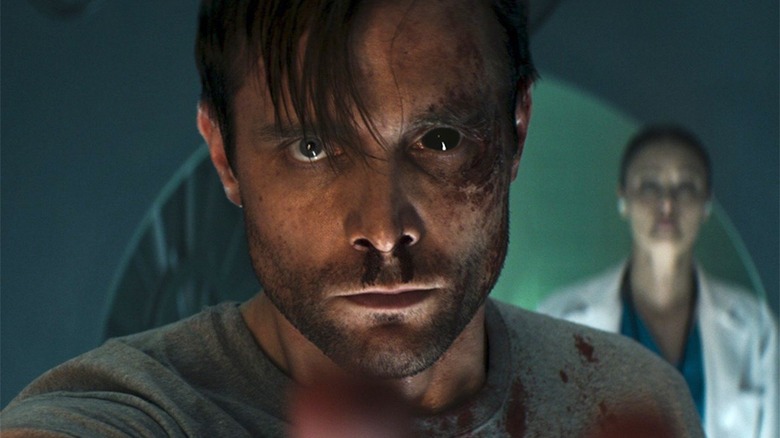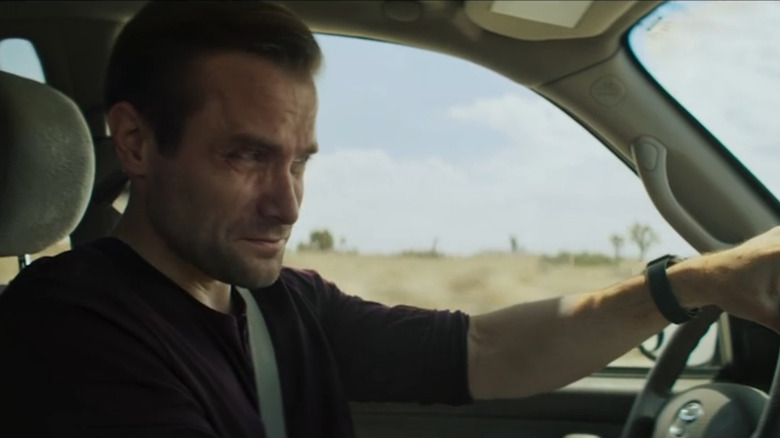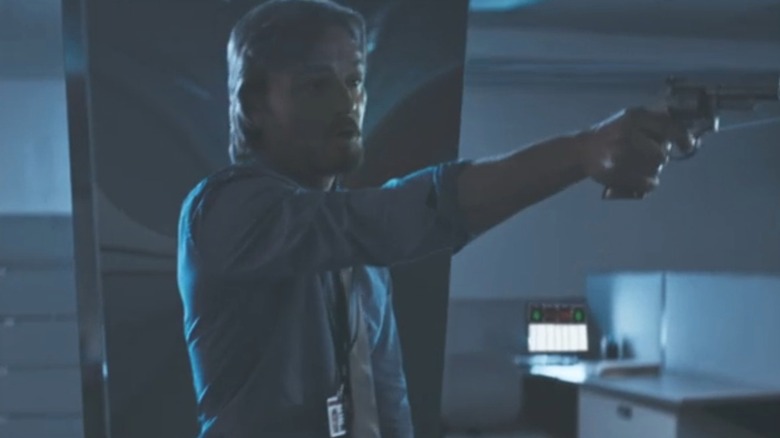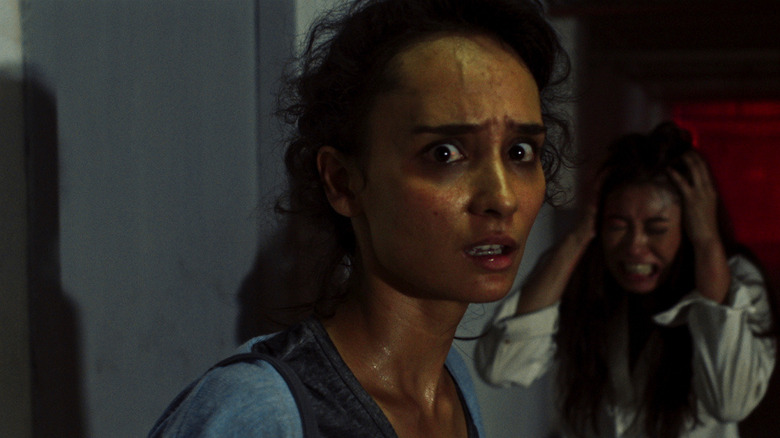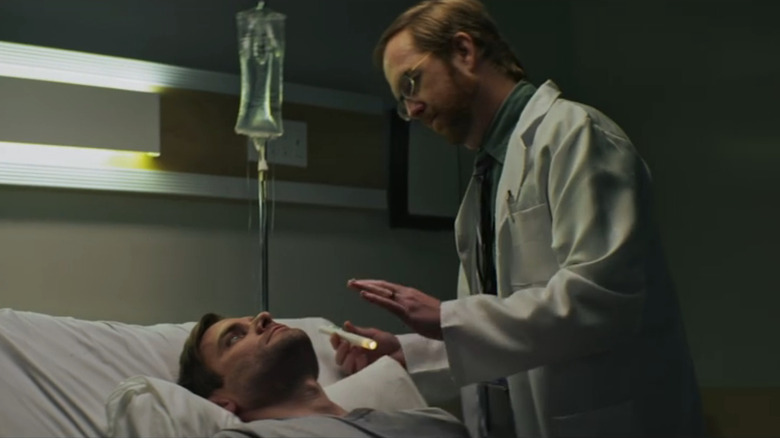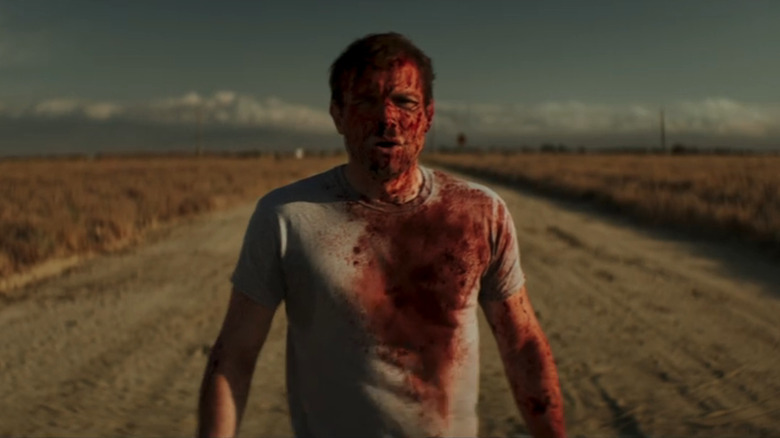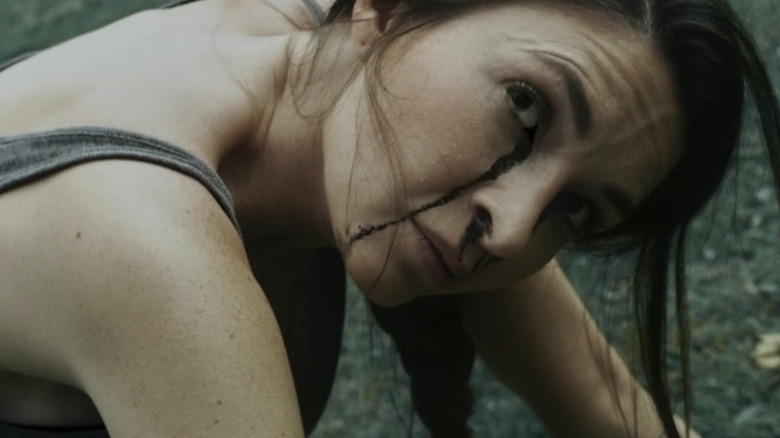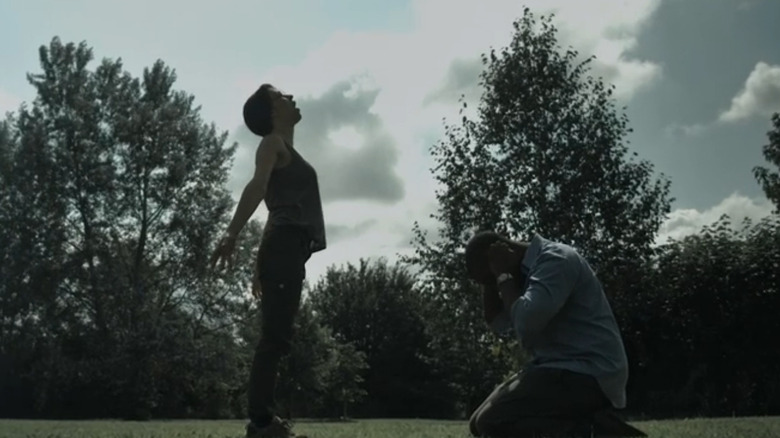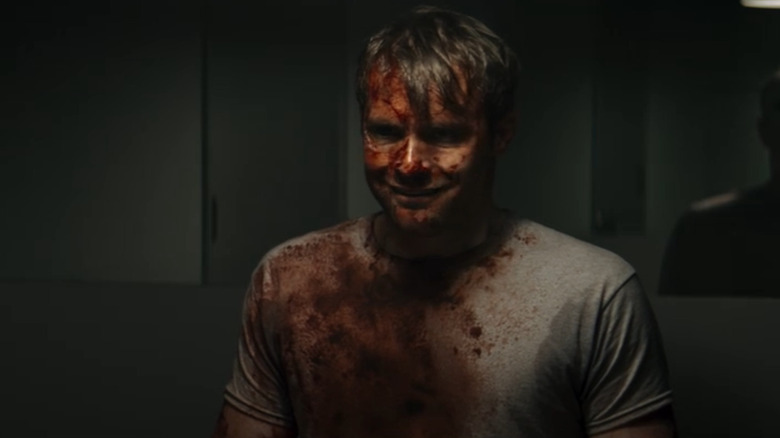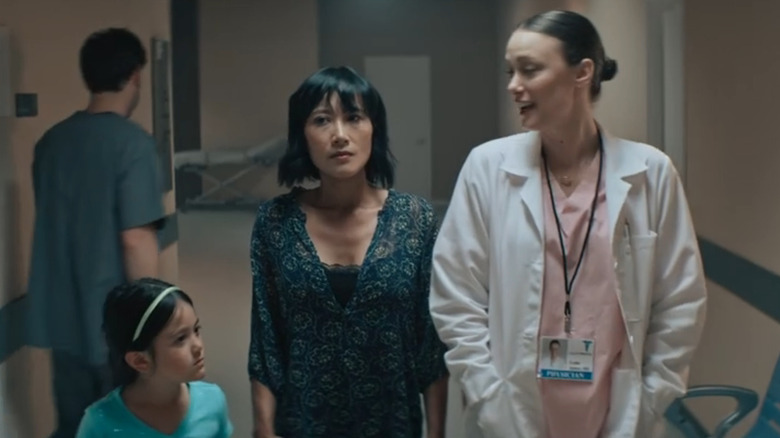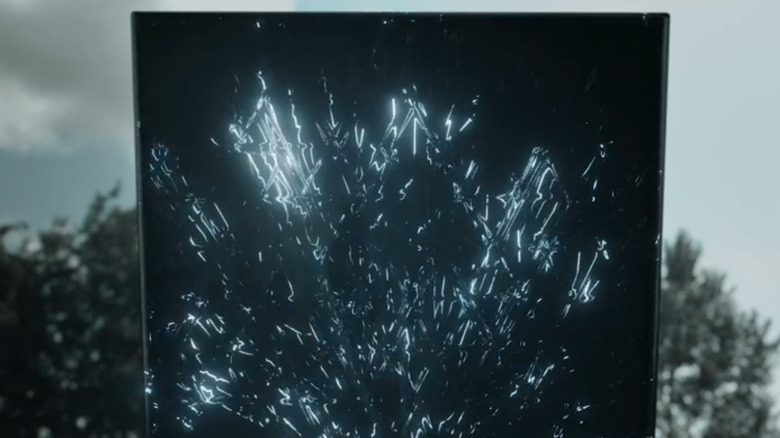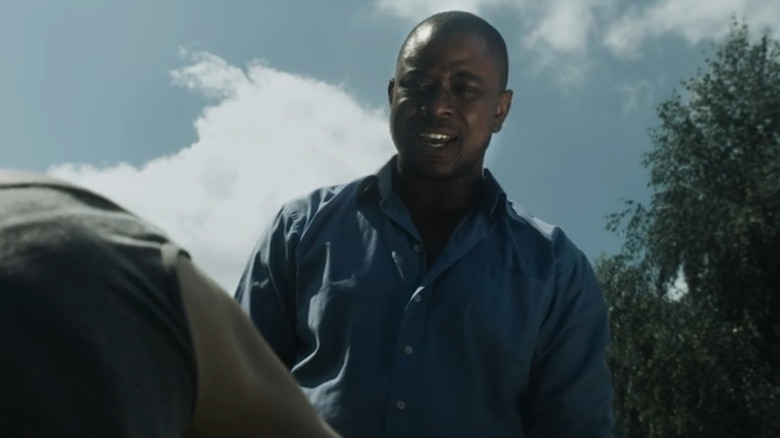The Ending Of Portals Explained
When it comes to low-budget indie shockers, one tried-and-true format is the horror anthology. Into this unique sub-genre in 2019 came "Portals," which took a unique approach by mixing disturbing scares with sci-fi weirdness. The film features four distinct segments, each with its own director — or co-directors in the case of the nail-biting installment "Call Center" — and its own set of characters. But unlike many anthologies, the four segments in "Portals" are all unified by a central idea, set against the backdrop of a global blackout that is followed by a series of black slabs appearing around the world with unknown intent.
Uniquely, "Portals" also eschews convention by not simply showcasing each story individually. In addition to two standalone stories — "Call Center" from directors Eduardo Sanchez and Gregg Hale, and "Sarah" from Indonesian filmmaker Timo Tjahjanto — a longer entry, director Liam O'Donnell's "The Other Side," is cut into pieces and presented in between. The entire film is also bookended by a story titled "The End."
With so many different stories and a lot of cryptic elements, there's a lot to unpack across every segment. While we still don't know everything about the film given its often-confusing and unanswered questions, we can offer a little help in explaining the ending of "Portals."
What you need to know about the plot of Portals
"Portals" makes about as much sense as you'd expect for a film with so many different directors. Comprised of four separate but vaguely interconnected stories, it begins with a faux interview with a pair of scientists who claim to have invented the world's first artificial black hole right here on planet Earth. But as fate would have it, there are unexpected consequences to their scientific hubris and before long the Earth is in a full-on crisis as a mysterious power outage causes widespread panic.
The most disturbing consequence, however, is the unexplained appearance of countless black monoliths that emit low-level radiation, and appear to be doorways to parts unknown. Even more frightening is that when people encounter these black slabs they are inexplicably drawn to them, often claiming to hear voices urging them to walk through them. Those that do disappear through the doorways are never seen again.
As the stories unfold throughout the film we see the fallout of the portals' presence as they pull people in, leaving more questions than answers. What do the portals lead to, and what do they want? Are they part of the scientists' black hole experiment or is there some kind of alien power at work?
What happens at the end of Call Center
The first full segment in "Portals" is titled "Call Center," directed by Gregg Hale and Eduardo Sanchez, co-directors of the "A Ride in the Park" segment from 2013's "V/H/S/2." This time, they tell the story of a 911 call center that is fielding frantic calls from panicked people who have witnessed the arrival of the black monolithic portals. Many report people going missing, as the operators struggle to make sense of it.
One operator named Stan (Paul McCarthy-Boyington) believes he knows what these portals are, having been obsessed by a call about similar disturbances years before. His boss (Shellye Broughton) isn't buying it, but when one of the portals appears in the call center itself, Stan grabs a gun and takes his colleagues hostage. He believes that the object is talking to him and demands that they all walk through with him. His coworkers refuse, which seems to make the monolith angry: it soon refuses to let Stan through, much to his dismay.
Distraught at being denied the chance to experience the portal himself, Stan fires his gun at the slab, only for the ricochet to kill him instantly. Then, in a shocking twist, his boss approaches the portal and seems to be entranced by its spell herself. As police descend on the call center in response to an earlier silent alarm, the portal flashes, and when the officers enter, the room is empty and the portal is gone.
What happens at the end of Sarah
Directed by Timo Tjahjanto, the segment called "Sarah" focuses on Sarah (Salvita Decorte) and Jill (Natasha Gott), a pair of sisters living in Jakarta. While arguing in a parking garage — with Sarah holding a grudge over feeling like an outcast in the family — Jill reveals she is pregnant just before the power goes out, leaving them in total darkness. When emergency lighting ignites, the siblings find themselves staring at one of the portals, while a devastating humming sound causes Jill, and only Jill, extreme pain.
Before the sisters can get away, Jill comes under the portal's influence and begins mindlessly walking towards it. When Sarah tries to stop her, we realize they're not alone: dozens of other bystanders are headed zombie-like straight for the portal, some disappearing when they walk into it. One mother is killed after sending her baby through the unearthly gate.
Now desperate to save her sister, Sarah forces Jill back to reality after a brief struggle, but the portal won't let go that easily. After a tense confrontation with a zombie stranger, Jill forces them both through the portal. When Sarah emerges on the other side she's in an eerily empty parking garage. She is suddenly standing before Jill, who is seemingly possessed by an otherworldly entity and cradling a baby of her own. Jill hands her sister the baby and disappears, giving Sarah the child and love she's always wanted.
What you need to know about The Other Side
The one segment of "Portals" to be told in pieces, the opening of "The Other Side" is one of the first parts of the film. In it, we meet Adam (Neil Hopkins), Andrea (Phet Mahathongdy), and their daughter Kate (Ruby O'Donnell). Fleeing their home due to the widespread blackouts, Adam inadvertently drives the family car right into one of the first portals to appear. Following "Call Center," the film cuts back to reveal that Adam has survived the wreck, and is being held in a hospital run by the elusive Dr. Markonen (Ptolemy Slocum) and Nurse Leslie (Deanna Russo).
Markonen tells Adam that he must have his right eye surgically removed due to damage sustained in the accident. At the same time, he gets suspicious when he is repeatedly delayed from contacting his wife and daughter. After a troubling operation, though, Adam realizes they haven't removed his eye at all, and beneath the bandages, he finds his eye has become black, just like the portal, and appears to be speaking to him. He even begins hallucinating himself, talking in a demonic voice in a mirror, as it torments him with the promise of reuniting with his wife and daughter.
What happens at the end of The Other Side
At the end of "The Other Side," Dr. Markonen turns on Adam, desperate to communicate with the demonic entity in his eye. After Nurse Leslie kills Markonen to save Adam, she takes him deep into the confines of the hospital, where they have captured one of the monoliths. Leslie has been told by the entity that if she can coax Adam through the portal, it will spare her family. Adam agrees, believing his own wife and daughter are trapped inside as well.
When he arrives on the other side, he is face to face with his mirror self, possessed by the evil being, who offers him a deal: Give up both of his eyes to allow it to see our world and he will be allowed to stay with his wife and daughter. It suggests that everything he's experienced since the car crash may have been inside the portal. And if he doesn't give up his eyes to the creature, he will be forced out, to live without his family.
In a final moment of defiance, Adam gouges out both of his eyes, refusing to allow the entity access to Earth. In the segment's final moments, Adam's wife and daughter arrive to visit him in the hospital where he is revealed to have empty sockets where his eyes once were. It's not explicitly stated, but the reflection of the entity suggests he's back in the real world. Of course, nothing is ever what it seems in "Portals."
What happens at the end of Portals
The final scenes of "Portals" constitute the second portion of a segment simply titled "The End." It sees the return of the two scientists from the opening of the film, but this time not in an interview capacity. Instead, we find James (Dare Emmanuel) in a makeshift laboratory analyzing one of the portals. He's in communication with Anna (Georgina Blackledge), who is in a field elsewhere standing before a second portal. Anna enters her portal and finds herself arriving on the other side of the one in James' lab.
Ecstatic that their little experiment has worked, Anna urges James to go back through with her to prove it viable as a repeatable result. Reluctantly, James agrees and goes first, followed by Anna. On the other side, James arrives in the field we saw earlier, but Anna, for unknown reasons, takes a lot longer to arrive. And when she does, something is very wrong. Seemingly possessed by the entity from inside the portals, Anna's eyes stream with blood and she speaks in a voice that is not her own, just as the "mirror" version of Adam had.
Gripping her colleague James' head, she makes his skull explode with her bare hands and the aid of an unseen power, in a grisly expulsion of blood and flesh. But in the film's most ominous moment, "Anna" also teases a coming calamity even more dangerous than the portals themselves.
What does the ending of Portals mean?
Like a classic episode of "The Twilight Zone" or "The Outer Limits," the message of "Portals" seems clear: be careful what you wish for. More pointedly, however, the film seems to be cautioning against the rapid advancement of scientific progress. In the early days of atomic discovery, many warned of the coming dangers of nuclear power, and when the Large Hadron Collider was first switched on, some feared it could lead to the end of everything we know. In "Portals," scientists take those experiments in radical new science one step further, creating an artificial black hole — one of the most powerful interstellar phenomena known to man.
Beyond the consequences of Oppenheimer's bomb or the LHC, however, this new development is pure hubris, and now humankind must pay the price. When the project is activated, the world is thrown into chaos, and portals of unknown origin appear on Earth. What the scientists don't expect is that these portals lead to a cosmic dimension where an untold evil resides. Inadvertently giving this powerful demon-like entity from another dimension access to our world was never part of their plan, but that seems to be exactly what happens.
Sure, scientific advancement can be a wondrous thing. It can give us life-saving medicine and technologies that make the world a better place. But sometimes we might be better off leaving well enough alone and not messing with things we don't understand.
What is in the portals and what does it want?
With four separate directors and a multitude of different writers, not every story in "Portals" offers the same explanation as to what is on the other side of these doorways. It's clear that they lead to a place that is not quite what it seems, and often resembles the place they left behind. But no concrete elucidation is ever given for what lies beyond the portals.
What does appear to remain consistent is that the portals are the domain of an otherworldly entity which, if not quite evil, certainly doesn't have the noblest of intentions. Implied to be some kind of cosmic horror in the vein of H.P. Lovecraft, this being wants to peer into our world and seemingly tries to lure people into its own realm to gain access to our reality. How it selects its targets — who it chooses to communicate with and pull into its world, and who it decides to reject — is also never explained. But whether the realm is a manifestation of the person's own mind, or is deliberately created by the entity, is unknown.
One thing we do know that this being can do is possess the bodies of those who pass through it. In "Sarah," "The Other Side," and "The End," it takes over the bodies of Jill and Adam within its own realm, and it possesses Anna when she passes through it, maintaining its control once she returns to our reality.
What director Liam O'Donnell says about the meaning of Portals
When "Portals" was first released, "The Other Side" director Liam O'Donnell spoke with iHorror about the film, the challenges he faced making it, and what it all meant to him. As he tells it, the story of Adam is actually based on his own life experiences, as strange as that may seem in a story about cosmic evil and portals to other realms.
"When I was like four or five years old I had an optic nerve glioma," O'Donnell revealed. "I ended up having to go through multiple surgeries." For O'Donnell, "The Other Side" is a lot less about the evil inside the portal, but about the helpless feeling of having your life in the hands of others. "I just remember being a little kid and being so frustrated because this adult is breathing into your face, and they're prying your face open." Inspired to write about those feelings, he incorporated his own story into his segment: "It's about 33 years of trauma spilling out onto the screen."
But his tale is also about more than just his own life. "There's just that kind of modern existential dread about terrible things happening," O'Donnell explained. For him, the film poses questions about how we deal with the fear of such disasters and whether we'll be able to protect our loved ones. "Are you going to be able to rise to the occasion?" he wonders. "Are you going to be able to take care of them?"
What Eduardo Sanchez and Gregg Hale have said about Portals
Director Eduardo Sanchez, who helmed "Call Center" with Gregg Hale, has a long and varied career behind the camera, including directing TV shows like "Star Trek: Strange New Worlds" and "Yellowjackets." He's still probably best known for his debut directorial effort, 1999's "The Blair Witch Project." Like that film, he explained in a chat with iHorror, "Portals" is much more about the characters than anything else. That's why the movie never really explores the portals too deeply, leaving a lot of questions left unanswered.
"We really concentrated on the human side of it, as opposed to digging into any sort of explaining in any way what the Portal was," Hale told iHorror. Sanchez agreed that the real meat of the story isn't the sci-fi and horror elements, even if the evil cosmic entity is needed to tell the story. "You have to have an antagonist; you can't just have people reacting to the door," he said. "We definitely wanted to give it a little bit of personality, but we didn't want to lay a lot of ground rules that the other segments were going to have to tiptoe around."
As a result, "Portal" is ambiguous at times, but Sanchez added that the mystery of the portals is really just a jumping-off point: "We definitely love that idea of having the door pop up and then ... now what are the humans going to do?"
How Portals sets up a sequel
Released in 2019, "Portals" may have been an anthology, but because the different segments all take place in the same fictional universe, it's more like an ordinary horror movie than you might expect. As the different stories unfold, we also learn more about the portals and the evil that lurks inside, with new revelations throughout the film. When the film's final moments arrive, the culmination of all of the different segments surprisingly sets up a future for this world.
In the final segment, "The End," scientists James and Anna experiment on the portals they've created, and we learn that it may have initially been invented as a kind of transporter device. But as the entity that lives in an unknown realm within comes through to our world in Anna's body, it portends a dark future for humanity. Telling James that the portals are just the beginning, it hints that there is a larger, looming threat coming, apparently setting up a sequel.
Admittedly, it's been years since "Portals" arrived on VOD, and there has been no real talk of a follow-up. But we've seen anthology horror movies get sequels before, such as "V/H/S/2," so anything is possible.
